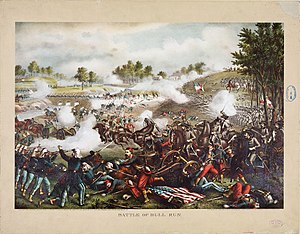Battle of First Manassas
| First Battle of Bull Run (Battle of First Manassas) |
|||||||
|---|---|---|---|---|---|---|---|
| Part of the American Civil War | |||||||
 First Battle of Bull Run. Chromolithograph by Kurz & Allison, 1889 |
|||||||
|
|||||||
| Belligerents | |||||||
|
|
|
||||||
| Commanders and leaders | |||||||
|
Political leaders: Military commanders: |
Political leaders: Military commanders: |
||||||
| Units involved | |||||||
|
Department of Northeastern Virginia:
|
|||||||
| Strength | |||||||
|
Army of Northeastern Virginia:
Patterson's Command:
|
32–34,000 (c. 18,000 engaged) |
||||||
| Casualties and losses | |||||||
|
2,708
(481 killed;
1,011 wounded; 1,216 missing) |
1,982
(387 killed;
1,582 wounded; 13 missing) |
||||||
|
Manassas National Battlefield Park
|
|

Stonewall Jackson's cannons on Henry House Hill
|
|
| Location | Prince William County, Virginia |
|---|---|
| Nearest city | Gainesville, Virginia |
| Coordinates | 38°48′46″N 77°31′18″W / 38.81278°N 77.52167°W |
| Area | 5,073 acres (20.53 km2) |
| NRHP Reference # | 66000039 |
Political leaders:
Military commanders:
Political leaders:
Military commanders:
Department of Northeastern Virginia:
Army of Northeastern Virginia:
Patterson's Command:
The First Battle of Bull Run, also known as Battle of First Manassas (the name used by Confederate forces), was fought on July 21, 1861 in Prince William County, Virginia, just north of the city of Manassas and about 25 miles west-southwest of Washington, D.C. It was the first major battle of the American Civil War. The Union's forces were slow in positioning themselves, allowing Confederate reinforcements time to arrive by rail. Each side had about 18,000 poorly trained and poorly led troops in their first battle. It was a Confederate victory, followed by a disorganized retreat of the Union forces.
Just months after the start of the war at Fort Sumter, the Northern public clamored for a march against the Confederate capital of Richmond, Virginia, which was expected to bring an early end to the rebellion. Yielding to political pressure, Brig. Gen. Irvin McDowell led his unseasoned Union Army across Bull Run against the equally inexperienced Confederate Army of Brig. Gen. P. G. T. Beauregard camped near Manassas Junction. McDowell's ambitious plan for a surprise flank attack on the Confederate left was poorly executed by his officers and men; nevertheless, the Confederates, who had been planning to attack the Union left flank, found themselves at an initial disadvantage.
Confederate reinforcements under Brig. Gen. Joseph E. Johnston arrived from the Shenandoah Valley by railroad, and the course of the battle quickly changed. A brigade of Virginians under the relatively unknown brigadier general from the Virginia Military Institute, Thomas J. Jackson, stood its ground, which resulted in Jackson receiving his famous nickname, "Stonewall". The Confederates launched a strong counterattack, and as the Union troops began withdrawing under fire, many panicked and the retreat turned into a rout. McDowell's men frantically ran without order in the direction of Washington, D.C.
...
Wikipedia

